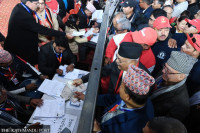National
Increasing concrete cover in Valley causing more urban floods
Experts for building infiltrating ponds to avert flood disasters and recharge groundwater.
Aakriti Ghimire
Since the pre-monsoon season began in Nepal, Surendra Man Bajracharya has been on high alert. It’s not just the extreme rainfall that has him worried. What concerns him more is that at any given moment, a flash flood could inundate the area outside his house in a low-lying area in Sanepa, Patan.
“The moment it rains heavily, there is no passage for the runoff stormwater. There is a ditch beside the road to allow water passage, but the ditch is always blocked, and the entire road gets flooded,” said Bajracharya, 62, a professor of Buddhist Philosophy at the Tribhuvan University.
“And we, the pedestrians and locals, have to face the consequences.”
Bajracharya’s house lies on the base of the hill of Sanepa, a walking distance from the Bagmati river. Given that his house is on a slope's base, all the stormwater from higher elevations gushes towards his locality.
When the water doesn’t get to flow, there’s a newly formed water body in front of his house almost every monsoon or whenever there’s a heavy rain, which has become the new normal.
According to hydrogeology and groundwater experts, with an increasing concrete cover in Kathmandu Valley, urban floods have become a common occurrence in residential areas where pools of water are formed by runoff stormwater at every other junction.
In July 2020, torrential rains inundated areas around the Hanumante river in Bhaktapur, flooding hospitals and schools, repeating the tale of disaster, destruction and loss each monsoon season.
In September 2021, Kathmandu Valley alone recorded 121.5 mm of rain on a single night, causing massive inundations in various areas of Kathmandu.
Balkhu, Kuleshwar, Narephant, Balaju and Mulpani were the most affected areas, while major road sections in Kumaripati, Tinkune, Jamal, Baluwatar, Bhadrakali and some parts of the Araniko Highway were flooded.
Every year floods in Kathmandu keep getting severe.
Experts say that black-topped roads and concrete built-up prevent water from seeping below the ground, causing a decline in groundwater in the Valley and resulting in urban flooding.
“Water takes a long time to permeate the soil and become groundwater. But we barely have any land from which water can permeate below,” said watershed expert Madhukar Upadhya. “Concrete houses, parking and garden areas are laid with stones. Roads are black-topped. Rainwater can’t pass through, so all the rain that falls manifests as a flood.”
Over the years, rainfall has also intensified.
Compared to the monthly average of the past three decades, rainfall in May in Kathmandu was 123.6mm, and the rainfall recorded as of May 18 is 150.70mm.
Meteorological records indicate the increase in pre-monsoon rainfall this season, implying that the rainfall will most likely be more intense in the upcoming monsoon, according to Bibhuti Pokharel, senior division meteorologist at the Department of Meteorology and Hydrology.
A synergistic effect of short-duration, high-intensity rainfall alongside urban sprawl has led to a decline in groundwater recharge. Since groundwater recharge is slow, rainwater doesn’t get absorbed on the ground covered with asphalt and concrete despite intense rainfall.
“The rate with which water gets absorbed by the soil is prolonged. If the rainfall rate is slow, infiltration is fast but if the rainfall occurs with heavy intensity, the infiltration is slow,” said Upadhya. “But water also needs to have a passage to the soil.”
Recognising that groundwater was declining, groundwater experts in the 1990s attempted to inject water into the soil in the ancient town of Bode in Bhaktapur. However, the attempt was a failure, said Upadhya, because it contradicted the principles of nature and physics.
“Water did not enter the waterbeds at all. We can’t force water to seep into the ground. It takes time and you need to give it that time,” Upadhya added.
Over the years, records also show that the groundwater levels in the Valley are varied and fluctuate seasonally but experts say much of it is fast depleting.
“During the monsoon, groundwater is easily available in shallow tube wells (within 40 meters) but in other seasons, water level drastically decreases because of the surface sealing by concrete,” said Dipendra Laudari, senior divisional hydrogeologist at the Ministry of Energy, Water Resources and Irrigation.
A study also finds that the effects of monsoon rain on groundwater are limited to agricultural lands within the valley. Groundwater recharge is limited in areas with concrete built-up, particularly in central parts of the Valley.
Additionally, the built-up area in Kathmandu is projected to increase by 21 percent between 2020 and 2050, predicting a significant implication for further groundwater depletion.
According to experts, despite the realisation that groundwater needs preservation, particularly in Kathmandu, which has a small watershed, there is no coordination between various government agencies while planning the city’s infrastructure.
“Groundwater preservation isn’t a matter of concern for groundwater experts alone. Preserving groundwater requires coordination among various departments that look after drinking water, water resources, geology, irrigation, electricity, drainage system, roads and bridges, and so on,” said Laudari.
In the absence of coordination among various departments and relevant authorities, individuals like Bajracharya have to bear the brunt.
“What we have to go through every time it rains is because of the sheer negligence of bureaucrats. There’s no proper planning to build roads. The slopes aren’t constructed well. If one department completes the work, another comes and demolishes it,” said Bajracharya. “There is zero coordination among these various departments.”
Bajracharya’s locality in Sanepa is but one instance. Across the Valley, the threat of a flash flood and inundation following extreme rainfall looms large.
As an immediate solution that can avert flooding disasters and recharge declining groundwater systems, experts propose building infiltrating ponds—a small square ditch that allows rainwater to flow into the ground directly—within the premises of every household across the Valley.
“The purpose of the pond is to create a depression where water can accumulate, which then acts as a funnel and buys time for water to infiltrate within the ground,” said Upadhya.
When built at community levels, such ponds can be four to five meters in width and a maximum of 1.5 meters in depth.
Experts say that a one square metre pond on the ground can do wonders at household levels and emphasise that the public should take ownership of building such ponds.
“We need to start building infiltrating ponds. Not just one or two, but make it mandatory that every household has an infiltrating pond so that rainwater can go directly into the soil,” said Upadhya. “And this has to become a campaign.”
If rain falls in a decentralised manner, all across the Valley, we should also decentralize the infiltration process, Upadhya added.
Experts believe that immediate actions need to be taken to address the problem of urban flooding in Kathmandu by providing rainwater access to the ground.
However, locals are frustrated at the negligence of the local leaders in dealing with such problems. Their problems are neither heard nor solved.
“They should have devised various engineering techniques while planning the roads and drainage systems. They didn’t. And today, no one cares. No one even bats an eye,” said Bajracharya. “No one hears our problems.”




 19.12°C Kathmandu
19.12°C Kathmandu















